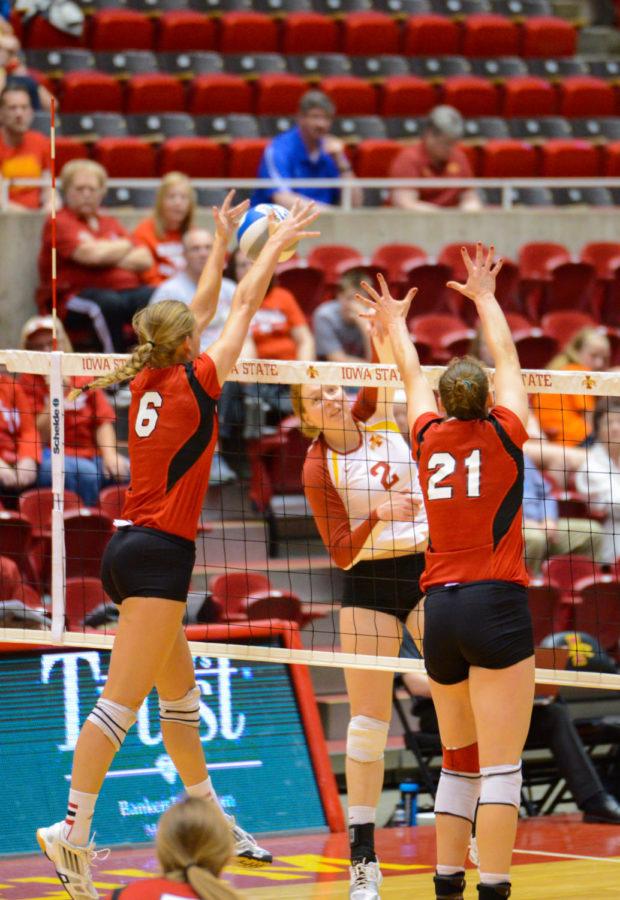ISU volleyball reflects on spring season, charts path for growth
Junior Mackenzie Bigbee smashes the ball during the Iowa State 4-0 loss to Nebraska on April 19, 2014 at Hilton Coliseum.
April 22, 2014
Two weeks, two tournaments and two matches against teams from last year’s top-20 for the ISU volleyball team. The spring exhibition season is now over for Iowa State, who won’t see competition again until its late-May trip across the pond for a European tour.
The spring season has served as a way for ISU coach Christy Johnson-Lynch to measure her team’s offseason growth and get an idea of what her lineups might look like come fall, when the regular season begins.
“I think we’re in a better place because going into spring I had no idea [what our rotations would be],” Johnson-Lynch said. “Some things are starting to work themselves out … It’s really shown us who’s ready to play at that level and who’s going to step up against the better competition.”
One of the players that stood out to Johnson-Lynch over the course of the spring season was right-side hitter Mackenzie Bigbee. Last season, Bigbee tallied double-digit kills in 19-of-28 matches en route to a team-high 324 kills on the season.
Now preparing for her junior season, Bigbee said she has seen the team make progress in some key areas over the last few weeks.
“Throughout the spring I think we’ve made big strides in our passing and defense,” Bigbee said. “Our hitters, we’ve been making better shot selections.”
Passing was Johnson-Lynch’s biggest point of emphasis heading into the spring season and is an area she said the Cyclones “really improved” in.
One of team’s best passers this spring was Suzanne Horner, a setter who transferred to Iowa State at the semester break after playing her freshman year at Mississippi State last fall. At MSU, Horner started 30 matches and racked up 978 assists.
In the final two matches of the spring season, against Creighton and Nebraska, Horner tallied 91 assists. At that pace, Horner would land in the 4-spot on Iowa State’s all-time assist leaders in just three years of wearing cardinal and gold.
Before she gets there, though, Horner said she’s working to develop a rhythm of a new group of hitters.
“In setting I feel like I’ve grown a lot. I’ve never really had any formal setter training so having that has been really nice,” Horner said. “Mainly, now, I’m just working on my tempo and my connection with the hitters.”
The spring season, particularly the final match against perennial powerhouse Nebraska, also showed the Cyclones where improvement is needed throughout the rest of the offseason.
The biggest concern, Johnson-Lynch said, is becoming more aggressive down the stretch of every set. Bigbee also thought Iowa State could do more to impose its will on opponents and noted that it will be necessary if the Cyclones want to contend with high-level teams.
“We didn’t really have the fire that you need [against Nebraska],” Bigbee said. “We really need to work on having that drive every point for the full set, not just a couple times. Individually, we just need to mentally assess how we can do that.”
If the Cyclones have learned anything this spring, it’s that they have the ability to compete with any team. To do that on a regular basis, though, Johnson-Lynch said her team will have to come together and be just that — a team.
“I think if you look player by player at each position, individually I think we’re very talented,” Johnson-Lynch said. “Tonight [April 19] we weren’t better as a group than we are as individuals. I think that’s all about mental toughness and working on putting the team before self.”







